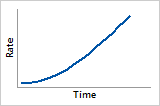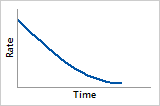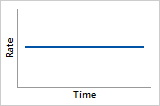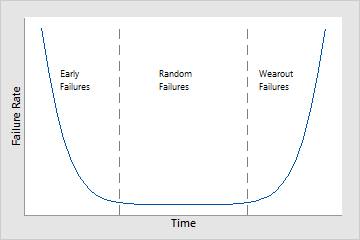The hazard function is the instantaneous rate of failure at a given time. Characteristics of a hazard function are frequently associated with certain products and applications. Different hazard functions are modeled with different distribution models. You can also model hazard functions nonparametrically.
- Increasing hazard function
-
Indicates that items are more likely to fail with time. For example, many mechanical items that are prone to stress or fatigue have an increased risk of failure over the lifetime of the product. Engineers might use a test to simulate wear-out stress. For example, engineers could simulate extended usage of a light bulb over time and then record the time until a failure occurs.
A Weibull distribution is often used to model this type of wear-out failure.

- Decreasing hazard function
-
Indicates failures that are more likely to occur early in the life of a product. One example is products or parts composed of metals that harden with use and thus grow stronger as time passes. Or errors in a computer program, which are more likely near the release of a new software program, but then decrease as time passes.
Often, this type of data can be modeled using a Weibull distribution with a shape parameter less than 1.

- Constant hazard function
-
Indicates failures that are equally likely to occur at any time in the product's life. This relatively constant period of low failure risk characterizes the middle portion of the Bathtub Curve.
This function can be modeled using the exponential distribution.

- Bathtub-shaped hazard function
-
Many products have failure rates that follow the "bathtub" curve. Often, the hazard rate is high initially, low in the center, then high again at the end of the life. Thus, the resulting curve of the three failure periods frequently resembles the shape of a bathtub. Televisions and handheld calculators are two products that commonly exhibit a bathtub-shaped hazard function. Also microprocessors, which may fail soon after being put into a computer system.
With Minitab, you can model a specific period of time in the bathtub function. Minitab models a decreasing hazard, constant hazard, or increasing hazard, but not all three sequentially over the life of the product.

